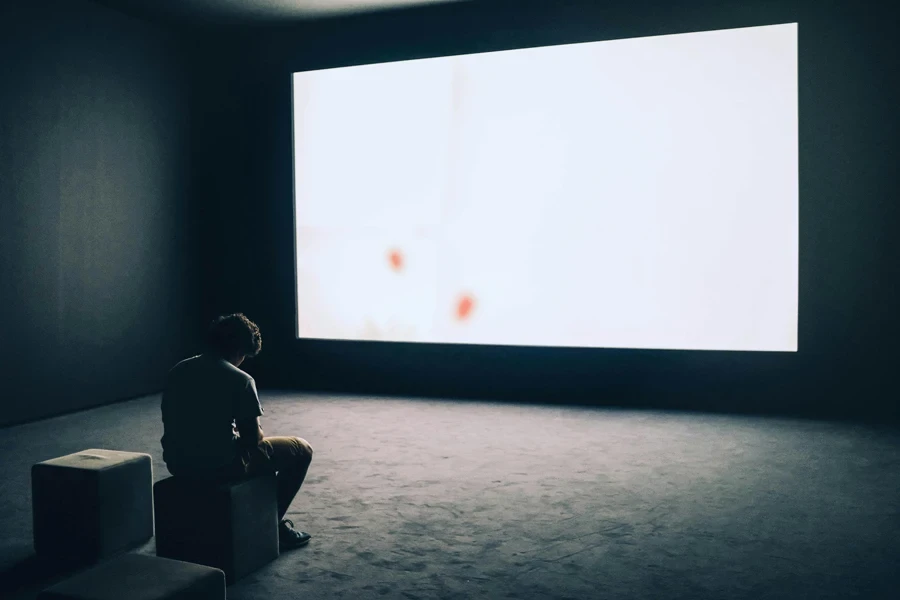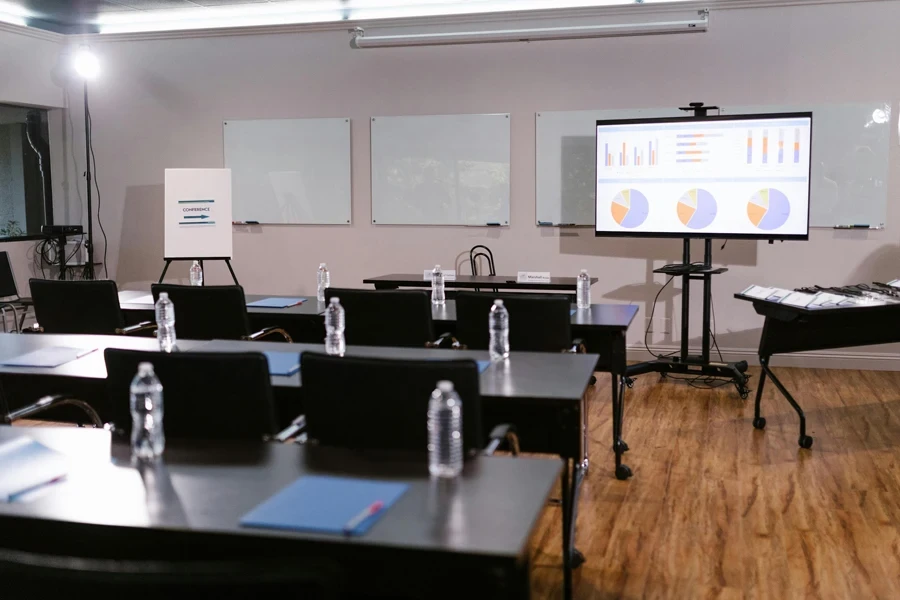Table of Contents
Introduction
Market overview
Key technology and design innovations
Portable and multi-functional screens
Ambient light rejection (ALR) technology
Interactive and smart features
Material innovations
Automated mechanisms
Top-selling models driving market trends
Screen Innovations’ Black Diamond series
Elite Screens’ portable solutions
Draper’s fixed frame and electric screens
Home theater-specific models
Regional model preferences
Conclusion
Introduction
The projection screen market is expanding rapidly, driven by innovations that enhance viewing quality and user convenience across various sectors. Rising adoption in educational institutions, corporate settings, and home theaters is boosting demand for advanced projection solutions. Technological advances, such as ambient light rejection, smart integration with touchscreen capabilities, and portable designs, are transforming traditional screen use and making it more versatile. Businesses are investing in high-performance screens to support collaboration, while consumers increasingly seek immersive experiences for entertainment at home. This growth trend positions the market for further evolution in professional and personal applications, paving the way for new designs and cutting-edge features to meet diverse user needs.

Market overview
In 2024, the global projection screen market is valued at around USD 44.35 billion, and it is expected to grow to approximately USD 55.67 billion by 2033, with a CAGR of 2.3%, according to Spherical Insights. The market’s expansion is driven by increased adoption across education, corporate, and residential sectors, where projection screens are essential for enhancing presentations and providing immersive viewing experiences. North America accounts for roughly 40% of the market, largely due to advanced technology adoption in education and business. Asia-Pacific, projected to grow at a CAGR of 3.5%, benefits from rapid economic development and a rising focus on digital classrooms.
In terms of segments, portable screens represent about 40% of the market in 2024, thanks to their flexibility and ease of use in various settings like corporate meetings and outdoor events. The professional use segment is the largest, contributing over 50% of the market share due to the frequent need for projection solutions in corporate seminars, training sessions, and conferences. However, challenges persist, with high initial setup costs and competition from large-format LED and OLED displays potentially limiting the market’s overall growth potential.

Key technology and design innovations
Technological advancements in the projection screen market are driving significant changes, enhancing functionality, convenience, and image quality. These innovations address traditional limitations and expand the use cases for projection screens, making them suitable for diverse environments, including education, corporate, and residential settings. New developments in portability, interactive features, material design, and automation are meeting evolving user demands for more versatile and high-performing screens.
Portable and multi-functional screens
Recent innovations in portable screen designs, such as roll-up, floor-rising, and ultra-lightweight models, provide users with enhanced flexibility for mobile projection needs. These screens can be quickly set up or dismantled, making them suitable for temporary or multi-location use, such as trade shows, corporate training sessions, and outdoor movie nights. Portable screens now often feature robust materials that can withstand frequent transport and use without compromising performance. Their growing popularity is reflected in the high CAGR projected for this segment, as demand rises for adaptable solutions that can cater to various settings with minimal effort.
Ambient light rejection (ALR) technology
ALR technology has transformed the quality of projected images by significantly improving contrast and brightness in challenging lighting conditions. By selectively filtering out ambient light, ALR screens maintain vivid image clarity, even in well-lit rooms where traditional screens would suffer from glare. According to Zion Market Research, adopting ALR screens is especially prevalent in high-end home theaters and commercial spaces like conference rooms and retail displays, where high-resolution visuals (4K and 8K) are necessary. The technology’s ability to deliver clear, sharp images under different lighting scenarios makes it a preferred choice for professional and personal applications.

Interactive and smart features
Integrating interactive capabilities, such as touchscreen functions, wireless connectivity, and voice-activated controls, transforms projection screens from passive displays into interactive tools for collaboration and engagement. Users can annotate on the screen, control presentations remotely, or even use gesture-based interactions in educational and corporate settings. Automation, like motorized mechanisms that automatically adjust screen positioning, adds further convenience by enabling hands-free operation. These features are becoming increasingly important in professional environments, prioritizing ease of use and enhanced functionality during presentations or training sessions.
Material innovations
Innovations in screen materials drive improvements in projection quality, offering better performance through specialized coatings that enhance brightness, widen viewing angles, and provide greater durability. Some advanced materials now include ambient light-reflective surfaces, which help reduce glare and improve color accuracy, making screens suitable for large venues such as auditoriums and theaters. According to Coherent Market Insights, using coated materials ensures consistent image quality across various lighting conditions and viewing angles, supporting the increasing demand for high-resolution displays. These materials also contribute to the durability of the screens, making them a long-lasting investment for frequent users.
Automated mechanisms
Automated mechanisms are becoming a hallmark of premium projection screens, featuring motorized components allowing remote-controlled lowering, retracting, and even screen tension adjustments. Some systems offer programmable settings to remember user preferences, enabling customized viewing experiences at the touch of a button. Self-installing capabilities, where screens automatically adjust to optimal tension and positioning during setup, further reduce installation time and effort. This level of automation is particularly beneficial in commercial installations where quick and efficient setup is necessary and in luxury home theaters where seamless integration with other smart home technologies is desired.

Top-selling models driving market trends
Top-selling models in the projection screen market are shaping trends with advanced features and catering to specific user needs across various sectors. Leading brands are incorporating technologies such as ambient light rejection (ALR), portability, and automated mechanisms, which make these models highly popular among commercial, educational, and home theater users. The preference for certain models varies across regions, reflecting differences in market demands and usage scenarios.
Screen Innovations’ Black Diamond series
The Black Diamond series from Screen Innovations stands out due to its advanced ALR technology. It enhances image quality by filtering ambient light and delivering sharp visuals in bright environments. This series supports high-definition content, including 4K and 8K resolutions, making it a top choice for commercial spaces like conference rooms and home theaters. The screens are also designed to minimize glare and offer wide viewing angles, providing a versatile solution that adapts well to diverse lighting conditions. According to data from ProjectorScreen.com, these features make the Black Diamond series particularly popular in premium home installations and professional settings where high image quality is essential.
Elite Screens’ portable solutions
Elite Screens has gained significant traction with its range of portable projection screens in high demand across educational institutions and business environments. Their lightweight, foldable designs allow for easy transportation and setup, meeting the need for flexible projection solutions in classrooms, training sessions, and outdoor events. Using durable materials ensures these screens can be handled frequently while maintaining good projection quality. According to Spherical Insights, the portable screen segment is projected to grow rapidly, driven by the increased use of portable models in multi-location corporate events and mobile presentations.

Draper’s fixed frame and electric screens
Draper’s range of fixed-frame and electric screens is widely adopted in professional settings, including boardrooms, auditoriums, and large conference spaces. These models provide seamless surfaces and automated mechanisms that allow for convenient operation, such as remote-controlled lowering and retracting. Draper’s electric screens, in particular, cater to businesses that require quick and efficient presentation setup. According to Coherent Market Insights, the durability and precision-engineered design of Draper’s fixed frame screens also make them a preferred choice for permanent installations in spaces where high-quality visual presentations are a priority.
Home theater-specific models
High-end home theater models often feature retractable designs, wide aspect ratios, and specialized screen surfaces that enhance ambient light rejection. These features cater to the growing trend of home theaters, where users seek immersive viewing experiences similar to commercial cinemas. ALR technology is commonly incorporated into these models to ensure clear visuals, even in living rooms with moderate lighting. The popularity of home theater-specific screens reflects a shift in consumer preferences toward larger display solutions for residential use, particularly in regions like North America, where disposable incomes are higher and dedicated home theater spaces are more common.
Regional model preferences
The preference for certain projection screen models varies significantly across different regions. North America has a high demand for premium models that incorporate automation and ALR technology, aligning with the region’s strong focus on home entertainment and advanced corporate setups. In contrast, the Asia-Pacific market favors portable screens due to their versatility and suitability for dynamic educational environments. Europe shows a growing trend towards interactive screens, especially in corporate and academic sectors emphasizing digital learning and collaboration. According to Zion Market Research, these regional differences in model preferences are influenced by economic development, technological infrastructure, and cultural trends in digital adoption.

Conclusion
The projection screen market is poised for sustained growth, driven by technological advancements that cater to evolving consumer and professional needs. Innovations in ALR technology, portable designs, and smart features are transforming traditional screen usage, making projection screens more adaptable to diverse environments such as classrooms, boardrooms, and home theaters. The increasing demand for high-resolution displays and seamless user experiences continues to propel the adoption of premium models, especially in regions with strong economic development and digital infrastructure.
As competition from alternative displays like LED and OLED grows, projection screen manufacturers must continue innovating in material design and automation areas to stay competitive. By enhancing image quality and user convenience, companies can address the existing challenges and expand their market share. With a strong emphasis on technology-driven improvements, the projection screen market is well-positioned to meet the diverse requirements of various sectors while driving future growth.




